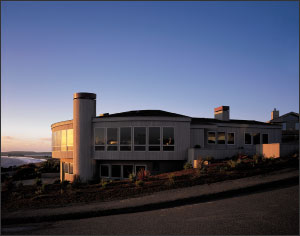
|
| The large
curve of this beach house follows the contours of the land and
the curve of the street. Stepping the lower level reduces the
bulk of the building. The curved chimney also softens the exterior.
The landscaping features indigenous planting which is resistant
to the local wildlife. The owner says quail and deer are frequent
visitors, along with the occasional mountain lion. |
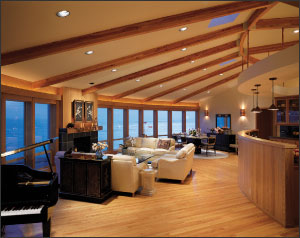 |
The
great room, with its 35ft radius, spans out in a wide arc from
the kitchen at right. The room faces the sun, but specially
treated glass has been used to reduce the amount of glare and
the damaging UV rays.
|
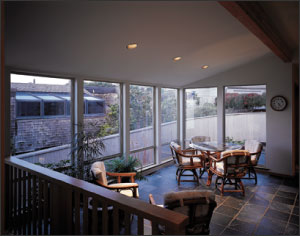
|
| The solarium
is used as a breakfast area. It also serves to bring light into
the kitchen, stairwell and gallery. |
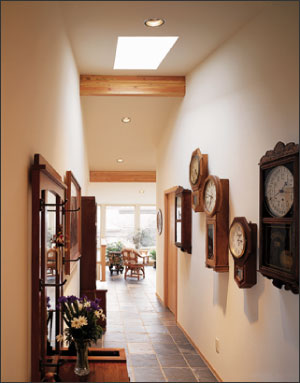
|
| The passage
leading to the solarium, or atrium, is designed as a gallery
for the ownerís antique clock collection. |
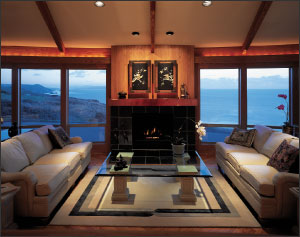
|
| Whichever
way you look, the circular design allows the best views from
the site. The main sitting area is centered in the great room,
either side of the fireplace. The mantel is made from copper,
and the hearth and fireplace surrounds feature slate. Recessed
incandescent ceiling lights have dimmers for mood lighting. |
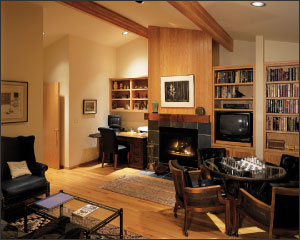
|
| In contrast
to the great room, the library is a cozy living space, which
can be used as a fourth bedroom. The paneling above the fireplace
is red oak. |
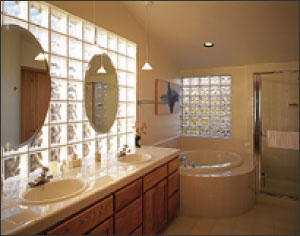
|
| Glass
blocks bring diffused light into the bathroom, which features
a whirlpool jacuzzi. |
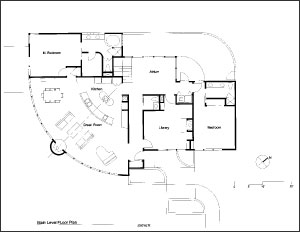
|
Architect
David Kingwillís plan for the main floor highlights the quadrant
shape which incorporates the great room.
|
|
Even with strict building ordinances,
inspired design is still possible, as this Pacific beach house shows
It may have the best view in the world, but that doesn't always mean a
building site will suit the house you want. Building regulations and restrictions
govern many subdivisions and often inhibit an architect's creative options.
This beach house, however, proves
that good design is still possible within strict parameters.
Architect David Kingwill admits the biggest challenge in designing such
a dramatic house was accommodating the building restrictions. These dictated
the height of the house, the pitch of the roof and even the type and color
of the cladding.
"The sloping site helped the design," he says. "We were able to step the
house down a level and gain extra space without affecting the roofline."
The curved contours of the street were also turned to advantage.
"Designing the house in a large
quarter circle allowed us to follow the curve of the street and also make
the most of the spectacular view," he says. "It's the main architectural
concept for the house and a shape which creates the drama inside as well."
To reduce the impact of the large building on the landscape, the lower
level of the house is stepped back by several feet. The curved chimney
is also designed to soften the exterior.
"Planter boxes at the front of
the house help avoid a flat plane, and lead the eye towards the entrance,"
says Kingwill.
Inside, the curved shape opens
up to reveal one large great room, which incorporates living, dining and
kitchen areas, as well as a grand piano.
"It's a perfect quadrant," says
owner Elva Brinegar. "The shape allows for 60ft of windows and every room
catches the view." While storms can be raging out in the bay, the great
room creates its own warmth. Natural timber features extensively, with
red oak flooring and paneling, and Douglas fir glue-laminated beams in
the ceiling.
A large fireplace, central to the
living area, features a copper mantel and slate hearth. "We made a conscious
effort to select materials that worked well
together," says David Kingwill. "Copper is a very warm metal which suits
the welcoming sense of retreat.
"The house catches the sunsets
beautifully and that glow is reflected in the copper. As well as the mantels,
copper is used on the kitchen countertop, backsplash and hood." Kingwill
says copper also
features in the light fittings, and it sheathes the metal rods which support
the curved soffit above
the kitchen counter.
The suspended soffit repeats the
curve of the timber beam in the ceiling directly above, as well as the
curve of the counter below. While the soffit supports hanging lights,
it also has lights on top to throw indirect lighting towards the ceiling.
Light dimmers control the mood of the house at night. They also contribute
to a sense of theatricality.
"It's a house designed for entertaining,"
says the owner. "I love to cook and I love to take part in my own parties,
so the kitchen is central to the layout of the great room."
A separate library is designed
for quieter moments. It also features the warm tones of red oak, leather,
and copper over a fireplace.
"I always like to have one intimate
room," says Elva Brinegar, "which I can pull up around my ears, and retreat
from the world."
Other rooms on the main floor include
the master bedroom, a second bedroom and an atrium, or solarium. This
is reached by a passage, which is wider than usual to accommodate the
owner's antique clock collection and furniture. The solarium also allows
more light into the kitchen, stairwell and gallery passage. Downstairs,
the quadrant shape is repeated on a slightly smaller scale to provide
a family and guest room.
"Overall, the design works very
well," says Elva Brinegar. "Despite the rigid rules governing the building
of this house, David Kingwill has managed to capture exactly the feeling
I wanted."
Resource List:
Architect:
David R. Kingwill, Sebastopol, CA
Builder:
Steve Schloming
Structural engineer:
Richard Hartwell
Energy consultant:
Sol Data
Electrical design and
build: TNT Electric
Cladding:
Cedar tongue and groove
Roof:
Asphalt shingles, Elk Prestique in Weatherwood
Window joinery:
Vinyl frames from Dee-Jay Sash & Glass and EPI
Door joinery:
Red oak veneer from Bergy Door
Joinery hardware:
Schlage from Bergy Door
Tiling:
Slate floors, hearths and fireplace, granite countertops and bathroom
ceramics from Dal Tile
Flooring:
Red oak from Quality Flooring Center Paints:
Kelly Moore
Lighting consultant and supplier:
Lighting Design Center
Heating:
Propane forced air from Antone Heating
Kitchen cabinets:
Red oak from Rhyne Design
Countertops and backsplash:
Copper from Copperworks; granite from Dal Tile
Sinks and faucets:
Moen from J Borg Plumbing
Wall oven:
Epicure from Dacor
Microwave and dishwasher:
KitchenAid
Refrigerator:
GE
Waste disposer:
ISE
Bathroom vanity cabinetry:
Red oak from
Rhyne Design
Vanity basin:
Kohler Farmington from
J Borg Plumbing
Bath and shower/tub:
Kohler Riva 5 acrylic from J Borg Plumbing
Toilet:
Kohler
Faucets:
Moen chrome
Bathroom flooring:
Bisquit tiles from Dal Tile
Trends-info:
For more information on these products and services, fax +64 9 571 5750
email: reception@trends.co.nz
Photography:
Tim Maloney
|